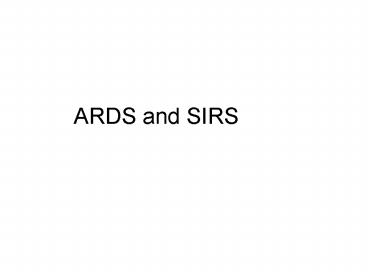ARDS and SIRS PowerPoint PPT Presentation
1 / 15
Title: ARDS and SIRS
1
ARDS and SIRS
2
ARDS
- Non-cardiogenic (low pressure) pulmonary edema
- An acute inflammatory lung injury in response to
a variety of insults - Acute inflammatory phase
- Cytokine activated neutrophils and monocyes
adhere to alveolar epithelium releasing
inflammatory mediators and proteolytic enzymes - This damages the alveolar capillary membrane,
increasing the permeability and causing alveolar
edema - Alveolar collapse occurs from reduced surfactant
- Hypoxemia/respiratory failure occur from loss of
functioning alveoli and V/Q mismatch - Fibroproliferative phase
- Progressive pulmonary fibrosis
- Pulmonary hypertension
3
ARDS
- Diagnosis
- Severe hypoxemia (PaO2/FiO2 lt200)
- Bilateral diffuse infiltrates on CXR
- Normal or only slightly elevated PCWP (lt18)
- Acute lung injury is the precursor to
ARDScriteria for diagnosis is the same except
there is a lesser degree of hypoxemia (PaO2/FiO2
lt300)
4
ARDS
- Direct pulmonary causes
- Infection
- Pulmonary trauma
- Near drowning
- Toxic gas inhalation
- Oxygen toxicity
- Gastric aspiration
- Indirect causes
- Sepsis
- Non-thoracic trauma
- Burns
- Hemorrhage
- Multiple transfusions
- Post arrest
- Bowel infarction
- Anaphylaxis
- Pancreatitis
- Uremia, toxins, eclampsia
- Drugs
5
ARDS
- Prognosis
- Mortality is high (50)
- Determined by precipitating condition and
increased with increasing age and associated
sepsis - Cause of death is multi organ failure
- Clinical features
- Acute inflammatory phase
- Lasts 3-10 days
- Hypoxemia and multi organ failure
- Progressive breathlessness, tachypnea, cyanosis,
hypoxic confusion, lung crepitations (frequently
misdiagnosed as heart failure) - Fibroproliferative phase
- Lung scarring and pneumothoraces are common
- Secondary and systemic infections are common in
both phases
6
ARDS
- Investigation/Monitoring
- Vital signsurine output
- Hemodynamic monitoring
- ABGs
- Microbiology to ID infections early
- Radiology
- Serial CXR shows progression of infiltrates
- CT scans demonstrate consolidation,
pneumothoraces, pneumatoceles, and fibrosis
7
ARDS
- Management
- ID and treat precipitating cause
- Mild disease O2, diuretics, CPT, NIV
- Severe disease mechanical ventilation
- Protective lung ventilation strategy
- Avoid oxygen toxicity
- Avoid excessive fluid loading
- General measures nutrition, sedation, infection
control - Additional measures NO, prone positioning,
bronchoscopy, ECMO, chest drainage
8
SIRS
- An inflammatory response to infective and
non-infective conditions - The inflammatory response seen with sepsis isnt
always due to infectionblood cultures are
positive in lt25 of cases of sepsis - Leading cause of multiple organ failure, ARDS,
acute renal failure, and late death following
trauma
9
SIRS
- Pathophysiology
- Initial cytokine release activates polymorphs,
endothelium, platelets, complement and
coagulation pathways - Activated white cells adhere to and damage
vascular endothelium, allowing fluid and cells to
leak into the interstitial space - Microcirculatory thrombosis impairs tissue oxygen
delivery - Vasodilation follows the release of inflammatory
mediators (NO) from the damaged vascular
endothelium - Systolic and diastolic myocardial dysfunction is
due to reduced coronary perfusion and the
negative inotropic effects of NO and other
inflammatory mediators - Impaired tissue oxygen utilization is caused by
sepsis-mediated cellular enzyme inhibition
10
SIRS
- Clinical features of septic shock
- Fever
- Tachypnea
- Tachycardia
- Oliguria
- Metabolic acidosis
- Elevated WBC
- CNS signs agitation, confusion, coma
- Pulmonary hypoxia/cyanosis, ARDS
- Hemodyanamic low BP, high CO, bounding pulses
(dilated shock) or peripheral shutdown
(vasoconstricted shock) - Renal tubular necrosis, oliguria
- GI splanchnic ischemia, ileus, GI bleed, liver
dysfunction - Hematologic coagulation disorders, DIC, low
platelet count, meningococcal rash - Other rhabdomyolysis, peripheral edema
11
SIRS
- Sites of underyling infection
- Meninges
- Sinuses
- Ears
- IV lines
- Lungs
- Endocarditis
- Abdominal
- UTI
- GI
- Toxic shock
- Joint/bone
- Chest infection is the most common source of
sepsis
12
SIRS
- Management
- ID and tx the cause
- Routine blood tests, C-reactive protein, plasma
lactate, coagulation profile, ABGs, cultures
(blood, sputum, wound) - General urinalysis, CXR, EKG
- Specific depends on suspected underlying cause
- ATB determine the most likely causitive
organisms and cover for thosechange once
organism is IDd - General measures
- Oxygen, respiratory support, nutrition,
prophylaxis against stress ulcer and
thromboemboli - Monitor VS, sat, ABG, biochemical profiles
13
SIRS
- Fluid, vasopressor, inotropic support
- Early in septic shock, widespread vasodilation
causes hypotension and relative hypovolemia - The reduction in LV afterload increases the CO
but inappropriate distribution causes regional
ischemia - Fluid administration increases the BP and
restores organ perfusion - As sepsis progresses, toxic myocarditis impairs
myocardial fx, reducing the COnow all those
fluid can cause pulmonary edema - Vasopressors (Levophed) an increase SVR and BP
without fluid administration, but CO may fall as
SVR increases if myocardial performance is
impaired - Inotropes (dopamine, epi) increase contractility
and can be used to maintain CO
14
SIRS
- Additional measures
- Activated protein C modifies microcirculatory
thromboemboli and prevent organ ischemia - Steroid therapy adrenocortical insufficiency is
common in severe sepsis - Antiinflammatory therapies are ineffective
- Sepsis prevention
- HANDWASHING and other infection control
- Microbiological monitoring
- Prophylactic antibiotics for some invasive
procedures - Prompt management of infection
15
SIRS
- About 20 of central venous catheters become
infected and lead to sepsis - Usually caused by poor insertion technique or
poor line care - Commonest organisms are S aureus, S epidermidis,
E coli - Infected lines should be removed and the tip
cultureda new line is placed in a different
siteATB - Prevention of line infection strict aseptic
insertion technique, firmly secured cannula,
closed systems, change infusion sets regularly,
change lines every 5-8 days

